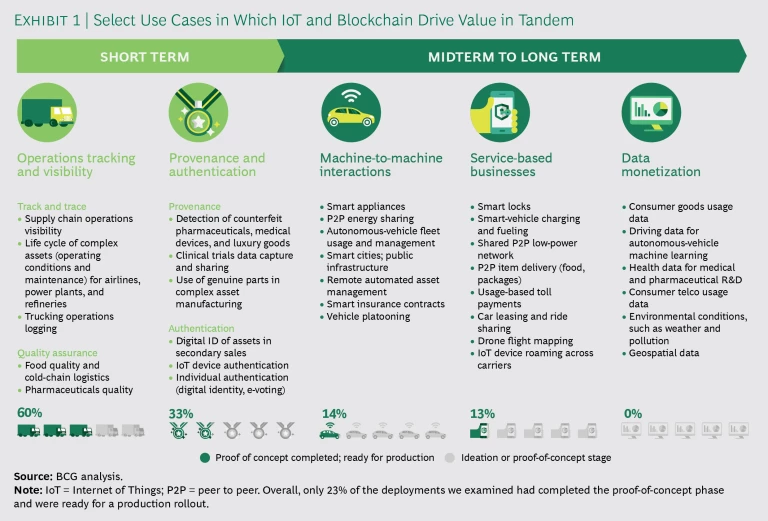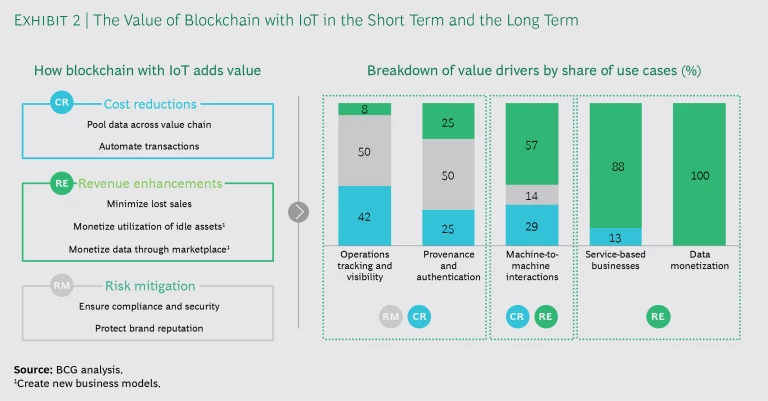The hype surrounding blockchain, the latest technology promising to upend the business world, seems matched only by the attention paid to another hot topic: the Internet of Things (IoT). Amid the noise, business leaders need to determine if experimentation that combines these two early-stage technologies can yield a sustainable competitive advantage.
Read more about the promise and impact of blockchain and the Internet of Things
Read more about the promise and impact of blockchain and the Internet of Things
- Pairing Blockchain with IoT to Cut Supply Chain Costs
- Stamping Out Counterfeit Goods with Blockchain and IoT
In this joint study by The Boston Consulting Group and Cisco Systems, our aim was to better understand how blockchain is being used by businesses building a distributed IoT network. Our research shows that only a small subset of companies have started down this path, and most of those experimenting with blockchain and IoT are still in the proof-of-concept phase. Still, already it’s clear that these nascent technologies, if paired together, can disrupt a variety of business sectors.
IoT: From Hype to Reality
As invariably happens with new technologies, hype helped define the early days of IoT. Investments in IoT have skyrocketed over the past two to three years but lag original estimates. According to a February 2018 IDC study, projected spending on IoT is expected to hit $1 trillion in 2020, which represents a robust, four-year compound annual growth rate (CAGR) of roughly 15%. It falls short of a December 2016 IDC projection, however, that forecast a market size of $1.29 trillion.
This shortfall reflects a healthy recognition of reality. Several factors have inhibited IoT’s growth, including a lack of technical standards, antiquated business and market structures, cultural issues, technological complexity, and security and privacy concerns. To address some of these issues, companies are turning to blockchain.
The Case for Blockchain with IoT
Our findings show that there’s a select subset of IoT-related applications for which blockchain is a perfect match. Generally, these blockchain-with-IoT use cases can create incremental value if they exhibit one or more of the following characteristics:
- The need for high trust and transparency across devices managed by multiple parties that don’t typically trust one another
- Reliance on a single version of truth by multiple stakeholders when individual records are error prone and the cost of lost or compromised data is very high
- Device authenticity; this is critical because the impact of rogue, tampered devices would be substantial
- Reliance on autonomous decision making and decentralized transactions
We identified more than 35 use cases of companies using blockchain with IoT and organized them into five categories: operations tracking and visibility, provenance and authentication, autonomous machine-to-machine interactions, service-based businesses (such as smart locks, smart vehicles, delivery, car leasing), and data monetization (consumer goods usage data, health data, and environmental conditions, including weather and pollution). (See Exhibit 1.)
Most of the applications we identified are still in the proof-of-concept phase, if not still on the drawing board. Our analysis shows that only around 25% of the use cases we examined had completed the proof-of-concept phase.
Progress varied across the applications. In two of the categories, participants expected to launch an enterprise-grade rollout in the subsequent 12 to 18 months. The first is operations tracking and visibility, where 60% of the applications were ready for production. The second is provenance and authentication, where 33% of the applications seemed ready for production. In the remaining three categories, scaled rollouts appeared likely to occur over the longer term. (Two more articles about blockchain with IoT are forthcoming. One involves track and trace in supply chains; the other concerns preventing the sale of counterfeit goods.)
Our research shows that the automotive and consumer industries are ahead of others when it comes to working with blockchain and IoT. Following close behind are health care, tech and telecom, and industrial goods. Nearly one-third of the deployments we identified are applicable across multiple industries. The remainder are industry specific.
The Economic Value of Blockchain with IoT
Blockchain with IoT can drive value for enterprises. (See Exhibit 2.)
Here are three ways:
- Cost Reductions. Blockchain allows for the creation of pooled, trusted data sets that can be shared among multiple stakeholders, thus replacing middlemen. This elimination of intermediaries, as well as the automation of transactions across the value chain, will result in cost efficiencies. Consider, for example, the automation of the customs-clearing process within a supply chain, which reduces (and potentially eliminates) the need for customs brokers.
- Revenue Enhancements. Existing enterprises can use blockchain with IoT to minimize lost revenues (through the prevention of counterfeit sales, for example). Blockchain can also unlock much of the value of IoT by making possible what otherwise wouldn’t be practical or scalable: in the use of smart contracts, for instance, to automate transactions and payments across devices. We anticipate an array of money-making opportunities within service-based businesses and with machine-to-machine interactions and data monetization.
- Risk Mitigation. Compliance requirements continue to grow more complex over time, partly as a result of globalization and digitization. Consider, for instance, the 2013 Drug Quality and Security Act, which outlines the steps that the pharmaceutical industry needs to take to electronically track certain prescription drugs distributed in the United States. Blockchain with IoT could help businesses satisfy this regulatory requirement by collecting and maintaining the required audit trails. Blockchain with IoT can also mitigate risk by ensuring the quality and authenticity of products throughout their life cycles, which can help protect a company’s name and reputation.
We expect that adoption of blockchain with IoT, and the resulting economic value, will occur in two phases, as has happened during other technology evolutions. In the short run, improvements in existing processes will drive value through cost reduction and risk mitigation. The long run will offer richer possibilities through revenue enhancement. We anticipate new business models emerging and see the potential for any number of new revenue streams.
The Challenges Ahead
We’re still in the early days of blockchain, and IoT is only now moving into the mainstream. Although pairing the two offers great potential, key challenges are likely to slow adoption:
- Limited Understanding of Blockchain. How IoT can drive value for a great variety of businesses is widely understood. Yet limited understanding exists for blockchain and how it can solve complex business problems. For example, more than 40% of non-IT, board-level executives in the UK recently admitted that they didn’t really understand blockchain, according to a survey by the search and recruitment consultancy MBN Solutions.
- Blockchain’s Poor Reputation. Businesses have generally embraced IoT. But blockchain is the underlying technology that gave life to Bitcoin and other cryptocurrencies, and blockchain’s reputation has suffered (unfairly) because of its association with initial coin offerings (ICOs), which has people legitimately worried about runaway valuations and a potentially dangerous bubble. Further eroding trust are reports, such as the one appearing in the Wall Street Journal in May 2018, that of the 1,450 digital coin offerings its reporters had reviewed, 271—or nearly one in every five—raised a red flag because of plagiarized investor documents, promises of guaranteed returns, or phantom executive teams. The hype surrounding blockchain may spark healthy skepticism, but it can also cloud rational judgment.
- Regulatory Uncertainty. Any new technology or set of technologies creates regulatory uncertainty as governments and regulatory bodies around the world wrestle with the potential impact of such advances. Some countries, including China and South Korea, have already banned ICOs, while others, including Switzerland, have taken a more relaxed stance. More debate among regulators is likely to emerge as the use of blockchain with IoT spreads.
- A Lack of Standards and Enterprise-Ready Platforms. Eventually, the industry will establish technical standards that will permit rival systems to integrate with one another. Until then, any early adopter of a blockchain-with-IoT solution will have to brace for problems with interoperability and scalability (if not obsolescence) if they tie themselves to a provider that doesn’t survive. Collaborations such as the Trusted IoT Alliance have only recently started to form in order to bring together key players in this sector. It’s still early days for a field that has seen the emergence of multiple competing blockchain platforms.
- A Need for Collaboration. Blockchain derives value from large-scale adoption. Buy-in from, and coordination among, multiple parties is essential to reap the benefits in most use cases we assessed. Increasingly, businesses are creating and joining industry-specific consortia because the true value in blockchain-with-IoT initiatives involves multiple parties willing to invest time, money, and effort as a group. That’s why companies need to involve all stakeholders when testing a new solution and invest in what’s called a minimal viable ecosystem, or MVE: a way of ensuring that the solution works for multiple participants.
- Where to Place Your Bets. More than 400 companies offer an IoT platform. We estimate that roughly 50 of them are enterprise ready. (See “Who Will Win the IoT Platform Wars,” BCG article, June 2017.) Introducing blockchain to the equation compounds the complexity. (See “Is Your Company Ready for Blockchain in IoT?”) Figuring out what platform(s) to bet on and who to partner with are significant challenges. Companies need to decide which capabilities to build internally, which to acquire, and in which situations strategic partnerships can help bring about a successful transition from both business and technology perspectives.
Is Your Company Ready for Blockchain with IoT?
Is Your Company Ready for Blockchain with IoT?
The following are some of the critical questions to consider if your organization is considering a blockchain-with-IoT solution:
- Does your company clearly understand blockchain and recognize that a blockchain-with-IoT solution can be employed without also using a cryptocurrency?
- Have you identified and gained executive alignment on viable IoT and blockchain use cases and ratified the ways blockchain can create additional value for your IoT solutions?
- Have you identified and brought on board key stakeholders, such as partners, suppliers, customers, and ecosystem players who are necessary to drive value in a blockchain-with-IoT investment?
- What are the business drivers that propel a decision to issue tokens or leverage cryptocurrencies, and how will you manage the associated risks, including regulatory uncertainty, potential volatility, and perceptions by customers and partners?
- Have you both identified the right blockchain platform and adopted a technology blueprint that is aligned with the identified blockchain-with-IoT use case to better understand the technical inhibitors with these technologies?
A Matter of Time
In the short run, the combination of blockchain and IoT will mainly focus on driving efficiencies inside companies and further automation of the paper trails needed to satisfy risk and regulatory requirements. Over the longer term, as both technologies mature, companies will use blockchain with IoT to develop and scale new revenue streams. Dynamics will shift as new business models materialize.
But the combination needs time to scale. In particular, blockchain needs time to mature and overcome some big obstacles—a lack of understanding as well as some technical and regulatory challenges—before it can achieve anything near its full potential and offer business leaders the solutions they need to drive significant economic value in their companies.






